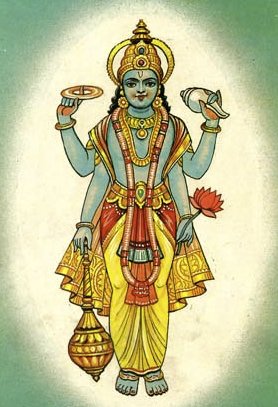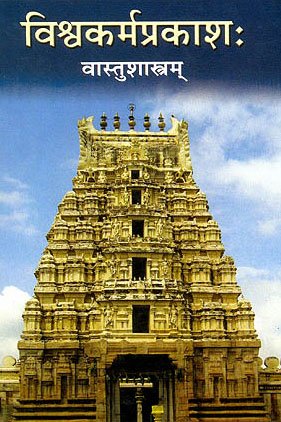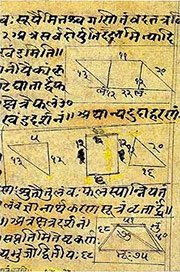Isha, Īṣa, Īśa, Īsā, Īsa, Iṣa, Isa, Īṣā, Iṣā: 27 definitions
Introduction:
Isha means something in Buddhism, Pali, Hinduism, Sanskrit, the history of ancient India, Marathi, Jainism, Prakrit, Hindi, biology, Tamil. If you want to know the exact meaning, history, etymology or English translation of this term then check out the descriptions on this page. Add your comment or reference to a book if you want to contribute to this summary article.
The Sanskrit terms Īṣa and Īśa and Iṣa and Īṣā and Iṣā can be transliterated into English as Isa or Isha, using the IAST transliteration scheme (?).
Alternative spellings of this word include Eesh.
Images (photo gallery)
In Hinduism
Purana and Itihasa (epic history)
Source: archive.org: Puranic EncyclopediaĪśa (ईश).—A Viśvadeva. (Universal deva). (Mahābhārata Anuśāsana Parva, Chapter 91, Verse 31).
Source: archive.org: Shiva Purana - English Translation1) Īśa (ईश) refers to one of the eight guardians of the quarters, according to the Śivapurāṇa 2.2.22. Accordingly as Śiva said to Sitā:—“[...] the different parts of the mountain Meru seem to be echoing the pleasing sweet sounds of bees etc. which cause the incitement of love of the guardians of the quarters viz. Indra, Kubera, Yama, Varuṇa, Agni, Nirṛti, Marut (Wind) and the Supreme lord (Īśa). Heaven, the abode of the Devas is stationed on the summits of the Meru wherein the cities of the guardians of the quarters are also situated. They are brilliant. Beautiful celestial damsels, Rambhā, Śacī, Menakā and others heighten their glory”.
2) Īṣā (ईषा) refers to the “poles” (of a chariot), according to the Śivapurāṇa 2.5.8 (“The detailed description of the chariot etc.”).—Accordingly, as Sanatkumāra narrated to Vyāsa: “The divine chariot of lord Śiva consisting of all the worlds was built by Viśvakarman with devoted effort. [...] The year constituted its velocity. The two Ayanas northern and southern constituted the junctions of the wheels and axles. The Muhūrtas constituted the joints and the Kalās the pins of the yoke. The division of time Kāṣṭhā constituted the nose of the chariot and the Kṣaṇas the axle-shaft. The Nimeṣas constituted the bottom of the carriage and the minutest divisions of time constituted the poles (īṣā). [...]”.
Source: Cologne Digital Sanskrit Dictionaries: The Purana Index1a) Iṣa (इष).—A son of Vatsara and Svarvīthi.*
- * Bhāgavata-purāṇa IV. 13. 12.
1b) The month sacred to Tvaṣṭā; aippaśi, one of the two months forming the śarat.*
- * Bhāgavata-purāṇa XII. 11. 43; Vāyu-purāṇa 30. 9; 50. 201; Brahmāṇḍa-purāṇa I. 13. 10.
2a) Īśa (ईश).—(Śiva) became Rudra through Lalita's grace.1 —also īśāna Image of;2 fourth mūrti as protecting Āditya.3
2b) A sādhya.*
- * Matsya-purāṇa 171. 43.
2c) Viṣṇu.*
- * Viṣṇu-purāṇa VI. 8. 60.
3a) Īṣa (ईष).—A Sudhāmāna god.*
- * Brahmāṇḍa-purāṇa II. 36. 28.
3b) A son of Auttama Manu.*
- * Matsya-purāṇa 9. 12.

The Purana (पुराण, purāṇas) refers to Sanskrit literature preserving ancient India’s vast cultural history, including historical legends, religious ceremonies, various arts and sciences. The eighteen mahapuranas total over 400,000 shlokas (metrical couplets) and date to at least several centuries BCE.
Shaivism (Shaiva philosophy)
Source: Shodhganga: Iconographical representations of ŚivaĪśa (ईश) is the name of a deity who was imparted with the knowledge of the Dīptāgama by Sadāśiva through parasambandha, according to the pratisaṃhitā theory of Āgama origin and relationship (sambandha). The dīpta-āgama, being part of the ten Śivabhedāgamas, refers to one of the twenty-eight Siddhāntāgamas: a classification of the Śaiva division of Śaivāgamas. The Śaivāgamas represent the wisdom that has come down from lord Śiva, received by Pārvatī and accepted by Viṣṇu.
Īśa in turn transmitted the Dīptāgama (through mahānsambandha) to Prabhañjana, who then transmitted it to Hutāśana who then, through divya-sambandha, transmitted it to the Devas who, through divyādivya-sambandha, transmitted it to the Ṛṣis who finally, through adivya-sambandha, revealed the Dīptāgama to human beings (Manuṣya). (also see Anantaśambhu’s commentary on the Siddhāntasārāvali of Trilocanaśivācārya)

Shaiva (शैव, śaiva) or Shaivism (śaivism) represents a tradition of Hinduism worshiping Shiva as the supreme being. Closely related to Shaktism, Shaiva literature includes a range of scriptures, including Tantras, while the root of this tradition may be traced back to the ancient Vedas.
Vaishnavism (Vaishava dharma)
Source: Pure Bhakti: Bhagavad-gita (4th edition)Īśa (ईश) refers to “controller. Sometimes refers to Viṣṇu and other times to Rudra”. (cf. Glossary page from Śrīmad-Bhagavad-Gītā).

Vaishnava (वैष्णव, vaiṣṇava) or vaishnavism (vaiṣṇavism) represents a tradition of Hinduism worshipping Vishnu as the supreme Lord. Similar to the Shaktism and Shaivism traditions, Vaishnavism also developed as an individual movement, famous for its exposition of the dashavatara (‘ten avatars of Vishnu’).
Vastushastra (architecture)
Source: Brill: Śaivism and the Tantric Traditions (architecture)Īśa (ईश) refers to one of the deities to be installed in the ground plan for the construction of houses, according to the Bṛhatkālottara, chapter 112 (the vāstuyāga-paṭala).—The plan for the construction is always in the form of a square. That square is divided into a grid of cells (padas). [...] Once these padas have been laid out, deities [e.g., Īśa] are installed in them. In the most common pattern 45 deities are installed.
Īśa as a doorway deity is associated with the Nakṣatra called Kṛttikā and the consequence is bhaya. [...] The Mayasaṃgraha (verse 5.156-187) describes a design for a 9-by-9-part pura, a residential complex for a community and its lead figure. [...] This record lists a place for worship at Īśa.

Vastushastra (वास्तुशास्त्र, vāstuśāstra) refers to the ancient Indian science (shastra) of architecture (vastu), dealing with topics such architecture, sculpture, town-building, fort building and various other constructions. Vastu also deals with the philosophy of the architectural relation with the cosmic universe.
Ganitashastra (Mathematics and Algebra)
Source: archive.org: Hindu MathematicsĪśa (ईश) represents the number 11 (eleven) in the “word-numeral system” (bhūtasaṃkhyā), which was used in Sanskrit texts dealing with astronomy, mathematics, metrics, as well as in the dates of inscriptions and manuscripts in ancient Indian literature.—A system of expressing numbers by means of words arranged as in the place-value notation was developed and perfected in India in the early centuries of the Christian era. In this system the numerals [e.g., 11—īśa] are expressed by names of things, beings or concepts, which, naturally or in accordance with the teaching of the Śāstras, connote numbers.

Ganitashastra (शिल्पशास्त्र, gaṇitaśāstra) refers to the ancient Indian science of mathematics, algebra, number theory, arithmetic, etc. Closely allied with astronomy, both were commonly taught and studied in universities, even since the 1st millennium BCE. Ganita-shastra also includes ritualistic math-books such as the Shulba-sutras.
In Buddhism
Mahayana (major branch of Buddhism)
Source: academia.edu: A Study and Translation of the GaganagañjaparipṛcchāĪṣā (ईषा) refers to the “pole” (of a vehicle), according to the Gaganagañjaparipṛcchā: the eighth chapter of the Mahāsaṃnipāta (a collection of Mahāyāna Buddhist Sūtras).—Accordingly, “The great vehicle (mahāyāna) is made with four wheels (cakra), namely with the means of attraction, the spokes (ara) are well fitted as the roots of good have been transformed with intention, it is well made with a deep nave (gambhīranābhi) as there is the immense knowledge of dependent origination, it is well kept together by the axle (akṣa) in order to bear the burdens of all living beings, the pole (īṣā) is firmly fixed since it is supported by the great friendliness and great compassion, [...]”.

Mahayana (महायान, mahāyāna) is a major branch of Buddhism focusing on the path of a Bodhisattva (spiritual aspirants/ enlightened beings). Extant literature is vast and primarely composed in the Sanskrit language. There are many sūtras of which some of the earliest are the various Prajñāpāramitā sūtras.
India history and geography
Source: Cologne Digital Sanskrit Dictionaries: Indian Epigraphical GlossaryĪśa.—(EI 23), the god Śiva; the king. (IE 7-1-2), ‘eleven’. Note: īśa is defined in the “Indian epigraphical glossary” as it can be found on ancient inscriptions commonly written in Sanskrit, Prakrit or Dravidian languages.

The history of India traces the identification of countries, villages, towns and other regions of India, as well as mythology, zoology, royal dynasties, rulers, tribes, local festivities and traditions and regional languages. Ancient India enjoyed religious freedom and encourages the path of Dharma, a concept common to Buddhism, Hinduism, and Jainism.
Biology (plants and animals)
Source: Google Books: CRC World Dictionary (Regional names)1) Isa in Ghana is the name of a plant defined with Celtis zenkeri in various botanical sources. This page contains potential references in Ayurveda, modern medicine, and other folk traditions or local practices It has the synonym Celtis stuhlmannii Engl. (among others).
2) Isa in Nigeria is also identified with Imperata cylindrica It has the synonym Calamagrostis lagurus (L.) Koeler (etc.).
3) Isa is also identified with Strophanthus hispidus It has the synonym Strophanthus niger Blondel, nom. nud. (etc.).
Example references for further research on medicinal uses or toxicity (see latin names for full list):
· Systema Naturae, ed. 2 (1759)
· Synopsis Plantarum Glumacearum (1855)
· Botanische Jahrbücher für Systematik, Pflanzengeschichte und Pflanzengeographie (1902)
· Icones et Descriptiones Plantarum, quae aut sponte … (1794)
· Flora Capensis (1898)
· Notizblatt des Botanischen Gartens und Museums zu Berlin-Dahlem (1900)
If you are looking for specific details regarding Isa, for example side effects, health benefits, pregnancy safety, diet and recipes, extract dosage, chemical composition, have a look at these references.

This sections includes definitions from the five kingdoms of living things: Animals, Plants, Fungi, Protists and Monera. It will include both the official binomial nomenclature (scientific names usually in Latin) as well as regional spellings and variants.
Languages of India and abroad
Pali-English dictionary
Source: BuddhaSasana: Concise Pali-English Dictionaryīsa : (m.) a lord; ruler. || īsā (f.), pole of a plough or a carriage.
Source: Sutta: The Pali Text Society's Pali-English DictionaryĪsa, (fr. iś to have power, perf. īśe = Goth. aih; cp. Sk. īśvara = P. issara, & BSk. īśa, e.g. Jtm 3181) lord, owner, ruler J. IV, 209 (of a black lion = kāḷa-sīha C.); VvA. 168. f. īsī see mahesī a chief queen. Cp. also mahesakkha. (Page 124)
— or —
Īsā, (f.) (Vedic īṣā) the pole of a plough or of a carriage S. I, 104 (naṅgal’īsā read with v. l. for naṅgala-sīsā T.), 172, 224 (°mukha): A. IV, 191 (rath°); Sn. 77; J. I, 203 (°mukha); IV, 209; Ud. 42; Miln. 27; SnA 146; VvA. 269 (°mūlaṃ = rathassa uro).

Pali is the language of the Tipiṭaka, which is the sacred canon of Theravāda Buddhism and contains much of the Buddha’s speech. Closeley related to Sanskrit, both languages are used interchangeably between religions.
Marathi-English dictionary
Source: DDSA: The Molesworth Marathi and English Dictionaryiśa (इश) [or इशरे, iśarē].—Interjection of disgust, Foh! fugh!
--- OR ---
isa (इस).—int Foh! fugh! See īsa.
--- OR ---
īśa (ईश).—m S A ruler, master, lord, sovereign.
--- OR ---
īsa (ईस).—n (or isāḍa) Pole of a plough. 2 A graffed stock.
--- OR ---
īsa (ईस).—Interjection of disgust, foh! fugh! 2 Used as s f n īsa mhaṇaṇēṃ To express disgust or disapprobation. Mostly with neg. con., as īsa dēkhīla mhaṭalī nāhīṃ or manānta īsa dēkhīla ālī nāhīṃ. Also To utter an ejaculation upon any sudden pain. See hāya.
Source: DDSA: The Aryabhusan school dictionary, Marathi-Englishiśa (इश) [-iśarē, -इशरे].—Interjection of disgust.
--- OR ---
isa (इस).—interj Foh ! Fugh !
--- OR ---
īśa (ईश).—m A ruler, lord, sovereign.
--- OR ---
īsa (ईस).—Interjection of disgust, Foh! Pugh!
Marathi is an Indo-European language having over 70 million native speakers people in (predominantly) Maharashtra India. Marathi, like many other Indo-Aryan languages, evolved from early forms of Prakrit, which itself is a subset of Sanskrit, one of the most ancient languages of the world.
Sanskrit dictionary
Source: DDSA: The practical Sanskrit-English dictionaryIṣa (इष).—
1) One possessed of sap or strength.
2) The month आश्विन (āśvina); ... ध्वनिमिषेऽनिमिषेक्षणमग्रतः (dhvanimiṣe'nimiṣekṣaṇamagrataḥ) Śiśupālavadha 6.49.
Derivable forms: iṣaḥ (इषः).
--- OR ---
Īśa (ईश).—a. [īś-ka]
1) Owning, possessing, sharing, master or lord of; see below.
2) One who is completely master of anything.
3) Capable of (with gen.)
4) Powerful, supreme.
-śaḥ 1 A lord, master; with gen. or in comp.; कथंचिदीशा मनसां बभूवुः (kathaṃcidīśā manasāṃ babhūvuḥ) Kumārasambhava 3.34 with great difficulty controlled (were masters of) their minds; so वागीश, सुरेश (vāgīśa, sureśa) &c.
2) A husband.
3) A Rudra.
4) The number 11 (derived from the eleven Rudras).
5) Name of Śiva (as regent of the north-east quarter.
6) The Supreme god (parameśvara); व्यक्ताव्यक्तं भरते विश्वमीश- मीड्यम् (vyaktāvyaktaṃ bharate viśvamīśa- mīḍyam) Śevt. Up.1.8; प्रसादये त्वामहमीशमीड्यम् (prasādaye tvāmahamīśamīḍyam) Bhagavadgītā (Bombay) 11.44. श्रीवत्सधामापररात्र ईशः (śrīvatsadhāmāpararātra īśaḥ) Bhāgavata 6.8.22.
-śā 1 Supremacy, power, dominion, greatness. Śvet. Up.4.7.
2) Name of Durgā.
3) A woman having supremacy; a rich lady.
--- OR ---
Īṣa (ईष).—[īṣ-ka]
1) The month Āśvina; cf. ईष् (īṣ).
2) A servant of Śiva.
Derivable forms: īṣaḥ (ईषः).
--- OR ---
Īṣā (ईषा).—[īṣ-ka]
1) The pole or shafts of a carriage or a plough. ईषा चक्रादिसंनिधाने चेदक्षमानयेत्युच्यते तदा यानाक्षमधि- कृत्य ब्रूते इति गम्यते (īṣā cakrādisaṃnidhāne cedakṣamānayetyucyate tadā yānākṣamadhi- kṛtya brūte iti gamyate) | ŚB. on MS.6.8.35. द्वीषम् (dvīṣam) (ratham) Bhāgavata 4.26.1. 'ईषा लङ्गलदण्डः स्यात् (īṣā laṅgaladaṇḍaḥ syāt)' इत्यमरः (ityamaraḥ)
2) A part of a chariot.
-ṣe (du.) The double or fork-shaped pole.
Source: Cologne Digital Sanskrit Dictionaries: Shabda-Sagara Sanskrit-English DictionaryIṣa (इष).—m.
(-ṣaḥ) The month A'swin, (September-October.) E. iṣ to go, ka affix; also īṣa.
--- OR ---
Īśa (ईश).—m.
(-śaḥ) 1. A name of Siva. 2. Also of the same deity as regent of the north-east quarter. 3. A ruler, a master. f.
(-śā) The shaft of a plough. E. īś to rule, ka aff.
--- OR ---
Īṣa (ईष).—m.
(-ṣaḥ) The month Aswin: see iṣa.
--- OR ---
Īṣā (ईषा).—f.
(-ṣā) The pole or shaft of a plough. E. īṣ to go, affixes ka and ṭāp; also īśā.
Source: Cologne Digital Sanskrit Dictionaries: Benfey Sanskrit-English DictionaryĪśa (ईश).—[īś + a], m., f. śā, 1. A proprietor, [Pañcatantra] i. [distich] 16. 2. A master, Mahābhārata 1, 1532. 3. A ruler, [Mānavadharmaśāstra] 9, 245. 4. A name of Śiva, Mahābhārata 13, 588.
--- OR ---
Īśā (ईशा).—[īś + ā] (also īṣā īṣā), f. The pole of a car, [Rāmāyaṇa] 6, 69, 46.
--- OR ---
Īṣā (ईषा).—see īśā.
Source: Cologne Digital Sanskrit Dictionaries: Cappeller Sanskrit-English DictionaryIṣa (इष).—1. (—°) [adjective] seeking.
--- OR ---
Iṣa (इष).—2. [adjective] vigorous, strong, fat, juicy, fruitful.
--- OR ---
Īśa (ईश).—[feminine] ā owner, disposer of ([genetive]), able to ([infinitive]). [masculine] lord, sovereign, chief of ([genetive] or —°); [Name] of Śiva, Kubera, & Rudra. [feminine] ā = seq.
--- OR ---
Īṣā (ईषा).—[feminine] the pole of a carriage; [dual] the double or fork-shaped pole, the thills.
Source: Cologne Digital Sanskrit Dictionaries: Monier-Williams Sanskrit-English Dictionary1) Iṣa (इष):—[from iṣ] 1. iṣa mfn. seeking (See gav-iṣa).
2) [from iṣ] 2. iṣa mfn. possessing sap and strength
3) [v.s. ...] well-fed, strong
4) [v.s. ...] sappy, juicy, fertile, [Ṛg-veda]
5) [v.s. ...] m. Name of the month Āśvina, (September-October), [Vājasaneyi-saṃhitā; Śatapatha-brāhmaṇa; Suśruta; Viṣṇu-purāṇa]
6) [v.s. ...] Name of a Ṛṣi, [Bhāgavata-purāṇa]
7) Īśa (ईश):—[from īś] mfn. owning, possessing, sharing
8) [v.s. ...] one who is completely master of anything
9) [v.s. ...] capable of (with [genitive case])
10) [v.s. ...] powerful, supreme
11) [v.s. ...] a ruler, master, lord, [Manu-smṛti; Śatapatha-brāhmaṇa; Mahābhārata; Kumāra-sambhava] etc.
12) [v.s. ...] m. a husband, [cf. Lexicographers, esp. such as amarasiṃha, halāyudha, hemacandra, etc.]
13) [v.s. ...] a Rudra
14) [v.s. ...] the number ‘eleven’ (as there are eleven Rudras)
15) [v.s. ...] Name of Śiva as regent of the north-east quarter, [Mahābhārata; Harivaṃśa; Rāmāyaṇa; Śakuntalā] etc.
16) [v.s. ...] Name of Śiva
17) [v.s. ...] of Kuvera
18) Īśā (ईशा):—[from īśa > īś] f. faculty, power, dominion, [Atharva-veda; Vājasaneyi-saṃhitā; Śatapatha-brāhmaṇa]
19) Īṣa (ईष):—m. the month Āśvina See iṣa
20) a son of the third Manu
21) a servant of Śiva.
22) Īṣā (ईषा):—f. (said to be [from] 1. īṣ), the pole or shafts of a carriage or plough
23) f. [dual number] (e) the double or fork-shaped pole, [Ṛg-veda iii, 53, 17; viii, 5, 29; Atharva-veda viii, 8, 23]
24) [xi, 3, 9; Śatapatha-brāhmaṇa; Kātyāyana-śrauta-sūtra; Mahābhārata] etc.
25) a plank, board, [Varāha-mihira’s Bṛhat-saṃhitā]
26) a particular measure, [Śulba-sūtra]
Source: Cologne Digital Sanskrit Dictionaries: Yates Sanskrit-English Dictionary1) Iṣa (इष):—(ṣaḥ) m. The month Āswin.
2) Īśa (ईश):—(śaḥ) 1. m. Shiva; a ruler.
3) Īṣa (ईष):—(ṣaḥ) 1. m. The month Āswin.
4) Īṣā (ईषा):—(ṣā) 1. f. Ploughshare.
Source: DDSA: Paia-sadda-mahannavo; a comprehensive Prakrit Hindi dictionary (S)Īśa (ईश) in the Sanskrit language is related to the Prakrit words: Īsa, Īsā.
[Sanskrit to German]
Sanskrit, also spelled संस्कृतम् (saṃskṛtam), is an ancient language of India commonly seen as the grandmother of the Indo-European language family (even English!). Closely allied with Prakrit and Pali, Sanskrit is more exhaustive in both grammar and terms and has the most extensive collection of literature in the world, greatly surpassing its sister-languages Greek and Latin.
Hindi dictionary
Source: DDSA: A practical Hindi-English dictionary1) Isa (इस) [Also spelled is]:—(pro) this, it; —[kāna se sunanā usa kāna se nikāla denā] in at one ear and out at the other;—[hātha de usa hātha le] early sow, early mow.
2) Īśa (ईश) [Also spelled eesh]:—(nm) God; Master; ~[koṇa] the north-eastern corner; ~[tā/tva] Godhood; mastership.
3) Īsā (ईसा) [Also spelled esa]:—(nm) Jesus Christ.
...
Prakrit-English dictionary
Source: DDSA: Paia-sadda-mahannavo; a comprehensive Prakrit Hindi dictionary1) Īsa (ईस) in the Prakrit language is related to the Sanskrit word: Īrṣ.
2) Īsa (ईस) also relates to the Sanskrit word: Īśa.
3) Īsā (ईसा) also relates to the Sanskrit word: Īṣā.
4) Īsā (ईसा) also relates to the Sanskrit word: Īrṣā.
Prakrit is an ancient language closely associated with both Pali and Sanskrit. Jain literature is often composed in this language or sub-dialects, such as the Agamas and their commentaries which are written in Ardhamagadhi and Maharashtri Prakrit. The earliest extant texts can be dated to as early as the 4th century BCE although core portions might be older.
Kannada-English dictionary
Source: Alar: Kannada-English corpusIṣa (ಇಷ):—
1) [noun] 1.ಆಶ್ವಯುಜ, [ashvayuja,] the seventh month in Hindu lunar month.
2) [noun] that which has vigour, strength.
--- OR ---
Īśa (ಈಶ):—
1) [noun] a lord a) a person having great power and authority; a ruler; a master; b) the owner and head of a feudal estate; c) one’s husband.
2) [noun] Śiva.
3) [noun] one of the eleven Rudras, (a class of deities).
4) [noun] the regent of north-eastern quarter.
5) [noun] (pros.) the sign for the long syllable.
--- OR ---
Īsa (ಈಸ):—[noun] Śiva.
Kannada is a Dravidian language (as opposed to the Indo-European language family) mainly spoken in the southwestern region of India.
See also (Relevant definitions)
Starts with (+164): Isadanta, Isadhara, Isaka, Isamvar, Isha kere, Isha wewe, Isha-drish, Isha-langulia, Ishabagola, Ishabala, Ishabija, Ishacala, Ishacapa, Ishacchvasa, Ishachapa, Ishada, Ishadadhyambhava, Ishadadhyamkara, Ishadadyambhava, Ishadadyamkara.
Ends with (+1195): Abalisha, Abhinishcikramisha, Abhipattisha, Abhiramadrisha, Abhrisha, Abhyudgatoshnisha, Abjoshnisha, Accavisha, Adharadisha, Adharisha, Adharmamahisha, Adhesha, Adhisha, Adhodisha, Adhvesha, Adisha, Adrak bayraisha, Adrisha, Advaitaratnakulisha, Advalisha.
Full-text (+541): Isadanta, Isadhara, Nirisha, Anisha, Ishadanda, Rathesha, Manisha, Hrishikesha, Ishasakhi, Umesha, Durisha, Isi, Ishambhara, Aisa, Bhutesha, Ishopanishad, Jagadisha, Amaresha, Hridayesha, Vagisha.
Relevant text
Search found 126 books and stories containing Isha, Īṣa, Īśa, Īsā, Īsa, Iṣa, Isa, Iśa, Īṣā, Īśā, Iṣā; (plurals include: Ishas, Īṣas, Īśas, Īsās, Īsas, Iṣas, Isas, Iśas, Īṣās, Īśās, Iṣās). You can also click to the full overview containing English textual excerpts. Below are direct links for the most relevant articles:
Rig Veda (translation and commentary) (by H. H. Wilson)
Hari-bhakti-kalpa-latikā (by Sarasvati Thkura)
Brihad Bhagavatamrita (commentary) (by Śrī Śrīmad Bhaktivedānta Nārāyana Gosvāmī Mahārāja)
Verse 2.1.132 < [Chapter 1 - Vairāgya (renunciation)]
Verse 2.4.102 < [Chapter 4 - Vaikuṇṭha (the spiritual world)]
Verse 2.4.26 < [Chapter 4 - Vaikuṇṭha (the spiritual world)]
Shrimad Bhagavad-gita (by Narayana Gosvami)
Verse 11.15 < [Chapter 11 - Viśvarūpa-darśana-yoga (beholding the Lord’s Universal Form)]
Verse 11.44 < [Chapter 11 - Viśvarūpa-darśana-yoga (beholding the Lord’s Universal Form)]
Verse 10.23 < [Chapter 10 - Vibhūti-yoga (appreciating the opulences of the Supreme Lord)]
Isopanisad (Madhva commentary) (by Srisa Chandra Vasu)
Shat-cakra-nirupana (the six bodily centres) (by Arthur Avalon)
